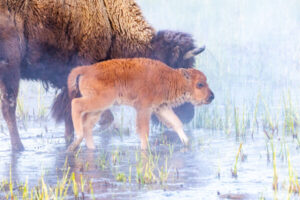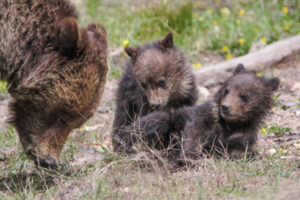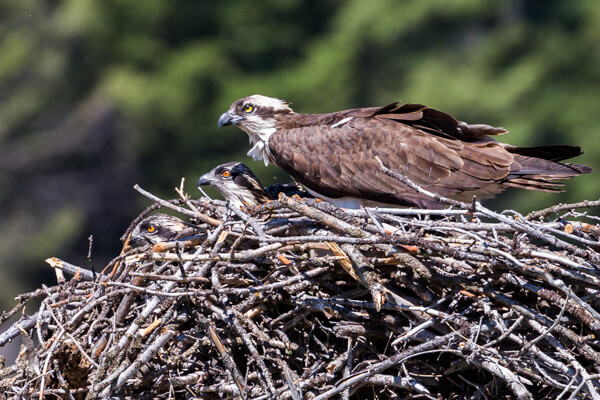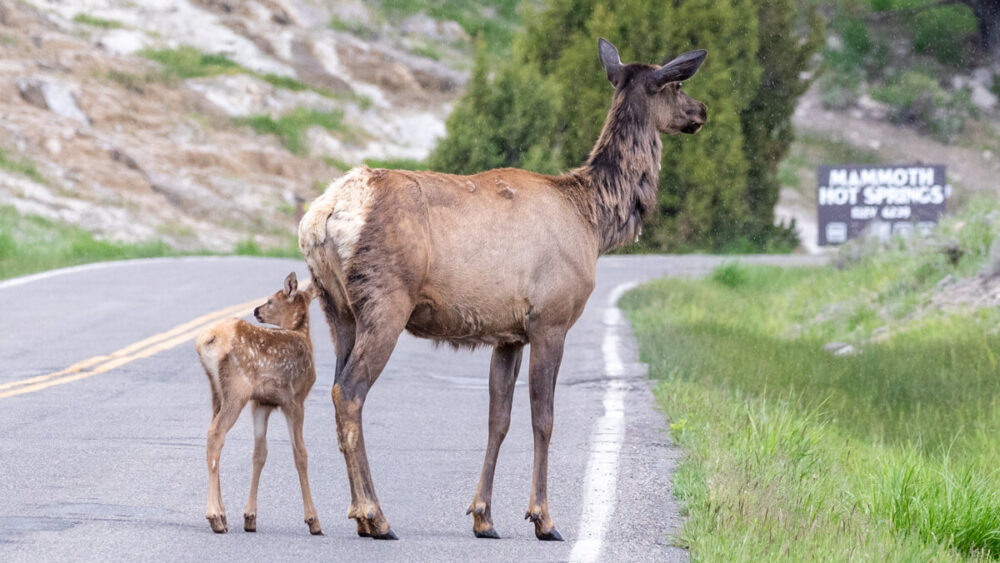Yellowstone National Park, a haven of biodiversity and a hotspot for wildlife enthusiasts, is home to a myriad of species that coexist in a complex and delicate ecosystem. Among the most captivating aspects of Yellowstone’s wildlife are the baby animals born each year, which play a crucial role in maintaining the ecological balance.
Visitors to Yellowstone often delight in watching these young animals as they explore their new world with an endearing mix of curiosity and playfulness. The sight of a bison calf bounding across a meadow or an elk calf cautiously taking its first steps can evoke a sense of awe and a deep connection to this place. The playful antics of these young creatures – bouncing, frolicking, and nuzzling their mothers – bring a sense of vitality and joy to the landscape. Here are just a few of Yellowstone’s spring babies –
Bison (Bison bison)

Bison calf and cow. YF / Matt Ludin
Bison calves, commonly referred to as ‘red dogs’* due to their reddish-brown fur, are born between late April and early May. These calves are precocial, meaning they are relatively mature and mobile at birth. Within a few hours, they are able to stand and follow their mothers, which is crucial for evading predators such as wolves and grizzly bears. This early mobility enhances their chances of survival during the vulnerable early days of their lives.
Elk (Cervus canadensis)
Elk calves, on the other hand, are born altricial in late spring and early summer. Initially, these calves are highly dependent on their mothers and spend their first weeks hidden in tall grass or thickets to avoid detection by predators. The mothers return periodically to nurse them. The spotted coats of elk calves provide effective camouflage, blending seamlessly with their surroundings and reducing the likelihood of predation. Observing an elk calf cautiously emerging from its hiding place to follow its mother highlights its survival instincts and the early stages of learning essential life skills in the wild.
Wolves (Canis lupus)
Wolf pups are born in April after a gestation period of about 63 days. A typical litter consists of four to six pups, which are born blind and deaf, relying entirely on their mother’s care. Within a few weeks, their eyes open, and they begin to explore their den surroundings. By autumn, these pups start accompanying the pack on hunts, learning the critical skills needed for survival. Watching wolf pups engage in playful wrestling matches and mock hunts provides a fascinating glimpse into their social structures and the development of their hunting skills.

Grizzly sow with her two cubs. NPS / Eric Johnston
Grizzly Bears (Ursus arctos horribilis)
Grizzly bear cubs are usually born in January or February while the mother is in torpor (hibernation). Cubs are altricial, born hairless and blind, weighing less than a pound. They rely on their mother’s rich milk to grow rapidly. By the time they emerge from the den in spring, they are more robust but still depend heavily on their mother for protection and learning essential survival skills, such as foraging and hunting. Observing bear cubs as they playfully tumble around their mother or cautiously investigate their surroundings is a highlight for many visitors, showcasing the mix of tenderness and raw power that defines these powerful animals.
Trumpeter Swans (Cygnus buccinator)
Trumpeter Swans typically lay eggs in late spring, with cygnets hatching after about 35 days of incubation. The cygnets are precocial, covered in downy feathers and capable of swimming shortly after hatching. However, they remain dependent on their parents for protection and guidance until they are fully fledged in late summer. The sight of fluffy cygnets gliding across a serene lake, closely shadowed by their protective parents, adds a picturesque charm to Yellowstone’s waterways.
Ospreys (Pandion haliaetus)

Osprey nest with two chicks. YF / Matt Ludin
Ospreys return to Yellowstone from their wintering grounds to breed in late spring. These raptors build large nests, often atop dead trees, or man-made structures. Osprey chicks hatch after about five weeks of incubation. They are semi-altricial, requiring significant parental care. Both parents contribute to feeding the chicks with fish caught in Yellowstone’s rivers and lakes. By mid-summer, the young ospreys begin to fledge, honing their fishing skills in preparation for migration.
The birth and survival of baby animals in Yellowstone are indicative of the health of the ecosystem. High survival rates among young animals suggest a well-functioning environment with adequate resources and effective predator-prey dynamics. Conversely, low survival rates can signal ecological imbalances or environmental stressors such as habitat loss, climate change, or human disturbance.
Conservation efforts in Yellowstone are critical for ensuring the continued vitality of its diverse wildlife. Park management strategies include habitat restoration, stringent regulations on human activity, and ongoing research to monitor animal populations and health. Public education and awareness are also paramount, as they foster a collective responsibility towards preserving this natural heritage. Yellowstone Forever, the official nonprofit partner of Yellowstone National Park, plays a crucial role in supporting these initiatives. Through funding and educational programs Yellowstone Forever helps enhance the park’s conservation efforts, ensuring that future generations can continue to experience and appreciate the park’s rich biodiversity.
Baby animals of Yellowstone National Park represent more than just a charming aspect of wildlife; they are fundamental components of a complex ecosystem. Their development, survival, and ecological roles underscore the intricate interdependencies that sustain the park’s biodiversity. Observing these young creatures offers invaluable insights into the natural world and emphasizes the importance of conservation efforts in maintaining the delicate balance of this iconic wilderness.
* We acknowledge that the term “red dogs,” while commonly used by Yellowstone National Park staff and visitors, is not inclusive of all cultural and traditional terms for baby bison, particularly those recognized and used by associated Tribes.

Comments are closed.